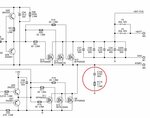R
red_alert
Guest

I've just tested my 2kW pure sine wave inverter and it's working just fine except a powerful audible noise from the LF (50Hz) output transformer.
I'm using a sPWM driven H-bridge to convert 24V DC to 16V AC then I'm using a step-up LF transformer to rise the AC to 230V. The transformer is from a broken UPS (APC Smart-UPS 1500).
I'm using an unipolar sPWM signal and I've tried different sample rates (carrier frequencies) - like 5kHz, 10kHz - but I've got the same(?) noise.
Unfortunatelly, I don't have an oscilloscope right now to look for the waveforms so I'm asking you guys if you have any clue about what's going on.
The humming/buzzing noise seems unchanged with or without (full) load. I'm using a 2uF capacitor in parallel with secondary (230V) winding. The primary (16V) winding is directly connected to the H-bridge output without any other filter (capacitor, inductor).
The inverter's design looks similar to APC UPS I've just mentioned earlier - even the output capacitor was used in the APC design.
I forgot to mention that the transformer it's not getting warm or something.. neither the MOSFETs (even at full load) but the noise it's very powerful and I'm worried about it.
I'm using a sPWM driven H-bridge to convert 24V DC to 16V AC then I'm using a step-up LF transformer to rise the AC to 230V. The transformer is from a broken UPS (APC Smart-UPS 1500).
I'm using an unipolar sPWM signal and I've tried different sample rates (carrier frequencies) - like 5kHz, 10kHz - but I've got the same(?) noise.
Unfortunatelly, I don't have an oscilloscope right now to look for the waveforms so I'm asking you guys if you have any clue about what's going on.
The humming/buzzing noise seems unchanged with or without (full) load. I'm using a 2uF capacitor in parallel with secondary (230V) winding. The primary (16V) winding is directly connected to the H-bridge output without any other filter (capacitor, inductor).
The inverter's design looks similar to APC UPS I've just mentioned earlier - even the output capacitor was used in the APC design.
I forgot to mention that the transformer it's not getting warm or something.. neither the MOSFETs (even at full load) but the noise it's very powerful and I'm worried about it.





